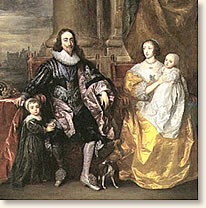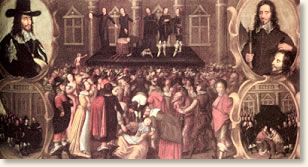|
The Execution of Charles I, 1649
King Charles I was his own worst enemy. Self-righteous,
arrogant, and unscrupulous; he had a penchant for making bad decisions. His troubles
began the moment he ascended the throne in 1625 upon the death of his father
James I. Charles simultaneously alienated both his subjects and his Parliament,
prompting
a series of events that ultimately lead to civil war, his own death and the abolition
of the English monarchy.
 |
| Charles I and family
|
Charles'
problems revolved around religion and a lack of money. His marriage to the Roman-Catholic French princess Henrietta Maria in 1625 did not please his Protestant subjects and led to suspicions of his motives. In 1637 he totally misgauged the sentiments of his Scottish subjects when he attempted to impose an Anglican form of worship on the predominantly Presbyterian population. Riots escalated to general unrest; forcing Charles to recall Parliament in 1640 in order to acquire the funds necessary to quell the Scottish uprising. This so-called "Short Parliament" refused Charles' financial demands and disbanded after only one month.
The continuing civil unrest in the north forced Charles to again convene Parliament in December 1640. The following year the Irish revolted against English rule while the determination of King and Parliament to assert their authority over the other led to open conflict between the two in 1642.
The tide of the Civil War ebbed and flowed for the next six years, culminating in the defeat at the Battle of Preston of Charles' army in August 1648 by Parliamentary forces under the command of Oliver Cromwell. The King was charged with high treason against the realm of England. At his trial, Charles refuted the legitimacy of the court and refused to enter a plea. Not withstanding the absence of a plea, the court rendered a verdict of guilty and a sentence of death declaring:
|
"That the king, for the crimes contained in the charge, should be carried back to the place from whence he came, and thence to the place of execution, where his head should be severed from his body."
|
Three days later, the king was led to the scaffold erected at Whitehall, London.
January 30, 1649 was a bitterly cold day. Charles went to his execution wearing two heavy shirts so that he might not shiver in the cold and appear to be afraid. The following account of the event comes from an anonymous observer and begins as the doomed King addresses the crowd from the scaffold:
"[As for the people,] truly I desire their liberty and freedom as much as anybody whomsoever; but I must tell you that their liberty and freedom consist in having of government, those laws by which their life and their goods may be most their own. It is not for having share in government, sirs; that is nothing pertaining to them; a subject and a sovereign are clear different things. And therefore until they do that, I mean that you do put the people in that liberty, as I say, certainly they will never enjoy themselves. Sirs, it was for this that now I am come here. If I would have given way to an arbitrary way, for to have all laws changed according to the power of the sword, I needed not to have come here; and therefore I tell you (and I pray God it be not laid to your charge) that I am the martyr of the people. . .
And to the executioner he said, 'I shall say but very short prayers, and when I thrust out my hands - '
Then he called to the bishop for his cap, and having put it on, asked the executioner, 'Does my hair trouble you?' who desired him to put it all under his cap; which, as he was doing by the help of the bishop and the executioner, he turned to the bishop, and said, 'I have a good cause, and a gracious God on my side.'
The bishop said, 'There is but one stage more, which, though turbulent and troublesome, yet is a very short one. You may consider it will soon carry you a very great way; it will carry you from earth to heaven; and there you shall find to your great joy the prize you hasten to, a crown of glory.'
The king adjoins, 'I go from a corruptible to an incorruptible crown; where no disturbance can be, no disturbance in the world.'
The bishop: 'You are exchanged from a temporal to an eternal crown, - a good exchange.'
 |
| The execution of Charles I
|
Then the king asked the executioner, 'Is my hair well?' And taking off his cloak and George [the jeweled pendant of the Order of the Garter, bearing the figure of St. George], he delivered his George to the bishop. . .
Then putting off his doublet and being in his waistcoat, he put on his cloak again, and looking upon the block, said to the executioner, 'You must set it fast.'
The executioner: 'It is fast, sir.'
King: 'It might have been a little higher.'
Executioner: 'It can be no higher, sir.'
King: 'When I put out my hands this way, then - '
Then having said a few words to himself, as he stood, with hands and eyes lift up, immediately stooping down he laid his neck upon the block; and the executioner, again putting his hair under his cap, his Majesty, thinking he had been going to strike, bade him, 'Stay for the sign.'
Executioner: 'Yes, I will, and it please your Majesty.'
After a very short pause, his Majesty stretching forth his hands, the, executioner at one blow severed his head from his body; which, being held up and showed to the people, was with his body put into a coffin covered with black velvet and carried into his lodging.
His blood was taken up by divers persons for different ends: by some as trophies of their villainy; by others as relics of a martyr; and in some hath had the same effect, by the blessing of God, which was often found in his sacred touch when living."
References:
The anonymous account of Charles' death appears in Robinson, James Harvey, Readings in European History (1906); Schama, Simon, A History of Britain vol. II (2001); Wedgwood, C. V, A Coffin for King Charles; the Trial and Execution of Charles I (1964).
How To Cite This Article:
"The Execution of Charles I, 1649," EyeWitness to History, www.eyewitnesstohistory.com (2003).
|






